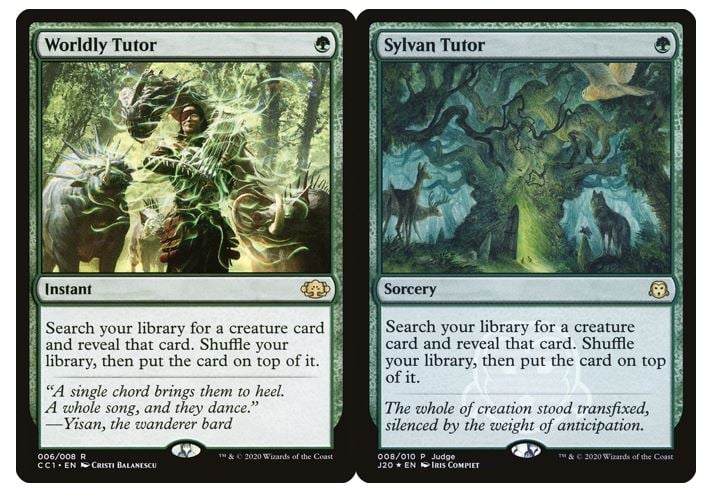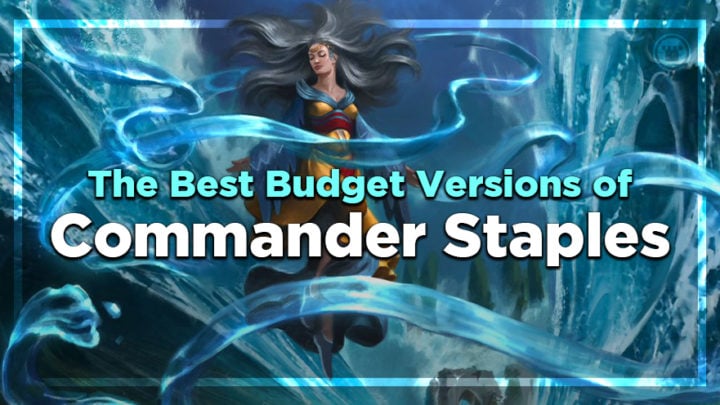Commander is probably the most budget-friendly format in Magic, where a well-built $100 deck can hold its own against decks with ten times the value. At the same time, that cost can be a huge barrier to entry; some of the most famous and popular cards in the format are simply out of reach for many players, and sometimes it can feel like you’ll have a hard time keeping up without them. Thankfully, this couldn’t be further from the truth.
Many of these expensive staples can be easily replaced with cards that either provide admirable imitations or can fill a similar role. It’s important to note that “budget” is subjective; not only will I cover affordable equivalents to extremely expensive cards, but I’ll also show the same for staples that are slightly lower on the cost scale. A $5 card by itself may not be expensive to most, but when most of the cards in your deck are around that price, they can really add up!
Finding The Balance
It’s important to note that the more expensive staples are pricey for one of two reasons: they’re either the most powerful and efficient version of the effect, or they’re the only card in their color(s) that can fill that role. By opting for a more affordable equivalent, you will be losing some degree of power or effectiveness. This isn’t necessarily a bad thing, though: you may not want to go ham with a deck that you expect to play against other budget or lower power decks. Balancing for the table is an important consideration, and cost can help to achieve this.
You might notice by now that when I write about budget Commander decks, I usually aim for a price point around $100. There’s only so much power $100 can get you, though the existence of a limit doesn’t mean it’s going to be on the lower end of the scale. Commander tends to follow the 80/20 rule: you can make a deck that’s 80% optimized, with just 20% of the budget, and it’s diminishing returns from that point onwards. That’s roughly what I’ll be aiming for with these alternatives: all budget equivalents I show will cost significantly less than the price of their premium counterpart, but will retain the majority of the original’s power.
The Staple: Stoneforge Mystic ($59.99)
Stoneforge Mystic, having returned from exile on Modern’s ban list, has consistently increased in price over the past few years. There are very few cards in Magic that can be as flexible and efficient as she is, but there are definitely a number of replacements that can make for a decent stand-in for a fraction of the price.
Option 1: Open the Armory ($0.69)
When you just need to get your hands on those Swiftfoot Boots, Open the Armory is a fantastic and efficient choice. While it doesn’t come with a body and can’t help you cheat on mana costs, it makes up for that in its flexibility. Not only does this fetch whatever sword you may need, but it can get you any Aura as well; this makes it a great inclusion in more decks, like Voltron or Enchantress.
Option 2: Stonehewer Giant ($5.49)
Stonehewer is so good that I don’t think calling it a budget version of Stoneforge Mystic does it justice. It may cost five mana to cast, but its activated ability can be repeated to tutor for multiple pieces of Equipment — and it automatically equips them, too! This is particularly useful for Equipment like Colossus Hammer or Argentum Armor to evade prohibitive equip costs.
Option 3: Relic Seeker ($0.35)
Relic Seeker may be a level or two below Stoneforge Mystic, but at less than 1% of the price, you’re getting a very good bargain. While the combat damage requirement can be tricky at certain tables, decks that want to run this will have many ways to help you connect. It doesn’t cheat on any costs, but providing a body at the same mana value as Stoneforge Mystic means it’s a more direct translation if they’re the parts you care about most.
The Staple: Cyclonic Rift ($22.99)
Next, we have the root cause behind many a Twitter argument and the rolling of countless players’ eyes. Just five simple words is enough to blow out the table: “End of turn, Cyclonic Rift.” Infamy aside, Rift is a staple because it’s the best at what it does: bouncing all of your opponents’ nonland permanents at instant speed. This level of overkill isn’t necessary in most scenarios; you can easily get away with running much more affordable options. These alternatives also tend to elicit milder reactions from the table, meaning they’re less likely to draw the ire of your opponents!
Option 1: River’s Rebuke ($1.79)
River’s Rebuke is one of my favorite mass bounce spells. It may be a sorcery, but it’s still an extremely powerful spell. In most games, resetting a single player’s board is all that’s needed to keep things from getting out of hand; anything more than that will only serve to prolong the game needlessly.
Option 2: Flood of Tears ($1.99)
If you find that multiple opponents need to be kept in check, Flood of Tears is the better choice over River’s Rebuke. But while it hits each opponent, it also hits you as well. This isn’t ideal — you may have to spend a few turns recovering, too — unless you have ways to mitigate the setback. I use this in my Glacian, Powerstone Engineer/Toggo, Goblin Weaponsmith deck as an emergency reset button. It works well because I run several cost reducers like Ugin, the Ineffable, so I can put them into play with Flood of Tears’ ability and replay most of my board immediately.
Option 3: Evacuation ($5.49)
If you really want to keep the instant-speed ability of Cyclonic Rift, you can use Evacuation as a way to maintain control during your opponents’ combat steps. There is a distinct difference between hitting only creatures over all nonland permanents, but this will still keep you safe in most circumstances. The tide of battle will often hinge on a single combat step, and you can still be sure it turns in your favor when needed.
The Staple: Damnation ($27.99)
When it comes to black wrath effects, Damnation is the gold standard. When you absolutely, positively have to kill every creature on the board, accept no substitutes. When you have to find something more suitable to your spend level, however, there are several great analogs!
Option 1: Crux of Fate ($3.99)
Crux of Fate is a popular board wipe among Dragon commanders for obvious reasons, but it’s a fantastic choice for any deck looking to control the board. It may not have the anti-regeneration rider, but that’s rarely relevant and generally not worth the additional expense. You can get cute with this wrath, too: if you’re facing a Dragons player, they’ll be in for a rude awakening! It may cost one more mana than Damnation, but it’s generally very playable, even at higher power levels.
Speaking of more expensive wraths…
Option 2: Deadly Tempest ($0.25)
As far as symmetrical wraths go, Deadly Tempest is among the best. In addition to punishing your opponents for overextending by removing their creatures, they also lose life proportionate to the amount of creatures they lost. While this does set everyone’s board back to parity, lowering life totals helps to mitigate some of the heavy tempo loss associated with wrath effects.
Option 3: Massacre Girl ($0.35)
The Rakdos cult’s finest assassin is one creature that more people should have in their roster. Her ability may seem situational on first glance, but it’s incredibly easy to set up a complete board wipe. If there’s a single creature with one toughness on board, then all creatures with two toughness die, on and on ad infinitum. If you’re looking for a way to remove any creatures with regeneration like Damnation does, Massacre Girl has you covered, too; reducing toughness doesn’t count as damage, and creatures with no toughness aren’t destroyed, so regeneration cannot apply.
The Staple: Wheel of Fortune ($299.99)
Wheel effects are one of the many facets of Commander that lure players in. There’s something satisfying about drawing a fresh hand, and drawing seven cards for three mana is better than any blue card draw spell! It does have the downside of drawing your opponents up to a full grip, but its political applications and ability to dig the whole table deeper to find an answer makes it a powerful tool in the right hands. The only problem is that it’s out of reach of most of those hands, with the cheapest copies going for more than $300! Surely we can knock a few dollars off that price?
Option 1: Wheel of Misfortune ($3.49)
Now that’s more like it! At around 1% of the cost, you can have your very own Wheel of Fortune… sort of. It performs the same for all but one player, and can potentially deal a lot of damage to one of the beneficiaries. Cards like this are enjoyable in Commander; they introduce drama and tension, as well as a clever minigame element. Wheel of Fortune may be a classic and incredibly powerful, but it doesn’t add the same level of depth to games as this does. Even if money were no object, I’d much prefer to play Wheel of Misfortune over the original!
Option 2: Valakut Awakening ($6.99)
Many players feel that Wheel of Fortune is often played incorrectly, giving your opponents more advantage than you’re giving yourself. To help prevent this, I cannot recommend Valakut Awakening enough; it’s a personal wheel effect that doesn’t give your opponents more cards. It’s also very different in that you tuck the cards from your hand rather than discard them, but that’s more of a difference than a downside. Unlike Wheel of Fortune, you can choose the number of cards you want to replace, so you can keep the relevant cards in your hand and ditch the duds. To top it all off, it can also be a land in a pinch! This is easily one of the best red cards printed in the past few years, and most decks would actually stand to benefit from running this over Wheel of Fortune itself!
Option 3: Runehorn Hellkite ($5.49)
While Runehorn Hellkite doesn’t fit in every deck as a perfect replacement for Wheel of Fortune, it does perform brilliantly in the right builds. Any deck that discards cards as part of their engine (like Anje Falkenrath) or makes use of their graveyard for value (Lord Windgrace; Neheb, Dreadhorde Champion) will love to pitch this in the early game, so they can draw a full grip later. The secret mode of this card is often overlooked, too: when you don’t need a wheel effect, you can always turn it sideways!
The Staples: Worldly Tutor ($24.99) / Sylvan Tutor ($54.99)

I’m including both of these tutors as the same entry, as they’re both pricey and functionally almost identical. They see a lot of play in more powerful decks, but scale well no matter what power level you play at. Thankfully, you don’t need to feel like creature tutors are out of your price range, as long as you know what you’re looking for!
Option 1: Time of Need ($0.99)
One benefit to legendary creatures in Commander is that the legend rule rarely ever comes up thanks to the format’s singleton nature. You can fit as many legends as you want into your deck, and never risk encountering duplicates like in 60-card formats. Time of Need can help you find any legendary creature in your deck for just two mana, and considering the wide range of targets available, it’s easy to build your deck with the right toolbox of creatures.
Option 2: Summoner’s Pact ($3.99)
A staple of Modern’s Amulet Titan, Summoner’s Pact doesn’t see nearly the same level of play in Commander, and it’s one tutor I feel has been overlooked for quite some time. A free tutor effect can be invaluable when you want to try and curve out, and this gives you access to all of your mana to do so. It does come with a few drawbacks — it sets you behind on the following turn, and it only fetches green creatures — but it’s still incredibly flexible nonetheless.
Option 3: Shared Summons ($2.79)
This might cost significantly more to cast than the original tutors, but its power is undeniable. The ability to search your library for any two creatures at instant speed is unbelievable; you could grab some value creatures to help you grind out, a two-card creature combo to go over the top of everyone, or anything in between. Yeva, Nature’s Herald particularly likes this, as it’s a way to generate card advantage while also holding up mana to flash in a creature, if needed. I’d recommend that more players try this card, no matter the budget!
***
Even if you’re on a budget, you can still play with some of the best cards in Commander. I hope I’ve shown that you can keep up with the heavy hitters of the format, even if they’re outside your price range.
If you’re looking for some more replacements for costly staples, you can listen to last week’s episode of The BM Cast; we talk about even more Commander staples and suitable replacements for them to maximize your budget!
What are your thoughts on these budget replacements? Do you have any cards that you prefer to run over the more popular staples? I’d love to see your secret tech: feel free to show me over on Twitter!

Scott is an Irish content creator and the Head of Budget Magic for the Izzet League. He focuses on affordable decks in Pioneer, Modern, and Pauper, particularly ones that stray from the mainstream. When he’s not writing about his favorite decks, he can be found talking incessantly about them on Twitter and on The Budget Magic Cast.

